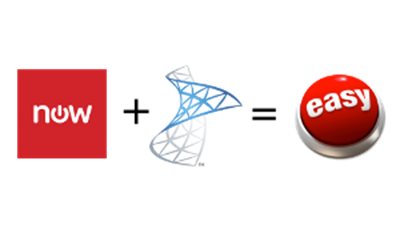Better Together: ServiceNow + System Center Configuration Manager
IT pros and CIOs have a lot of powerful tools at their disposal these days. Yet the strengths of each come with relative weaknesses in other areas, and nothing does it all. If we’re lucky, we find ourselves with the “best in class” product for each of our needs – and even then, some services remain difficult to deliver effectively.
Consider the example of software delivery. It’s a pretty straightforward, longstanding challenge: when a user needs a new application installed on their machine, we need a way to make that happen. IT teams have historically gone about this in a variety of ways:
-
Have users call the help desk which dispatches a technician to manually perform the install.
-
Set up a labyrinth file share with dozens of folders containing installers for each app. Savvy users help themselves, the rest still call the help desk.
-
Provide users with local admin privileges to install their own software to reduce the support burden. Help desk shifts focus to cleaning up the resulting malware infections.
-
Buy an expensive standalone “app store” product such as 1E Shopping.
-
Implement the Application Catalog that ships with SCCM but lacks request management and integration with the rest of the business.
-
Have users bring their own devices and hope they bring their own support.
Obviously, none of these are ideal options. Manual fulfillment is clearly inefficient, and wild-west file share self-service installs open up a very enticing attack surface to the hackers of the world. Isolated app stores are nice as far as they go, but represent yet another interface for users and administrators to grapple with.
Where does that leave us? With nice tools that don’t play well together to achieve the overall goal of simple, effective services that get business done.
Fortunately, technology has advanced far enough to provide not only the products themselves but also the means to effectively integrate them together into solutions. When evaluating products with an eye towards modern IT services, the question “what does it do?” has become less important than “what can it integrate with?” The more products and platforms we can intelligently weave together, the better IT services we can provide.
Back to the tools and the problem: ServiceNow admins know and love the platform’s request management and automation capabilities and encourage the rest of IT and the business to join them in providing “everything as a service” through a single pane of cloud-based glass. System Center admins know and love the proven and industry-leading software delivery capabilities of SCCM, and mock the ServiceNow admin for having a software “Order Now” button that does nothing but generate a request record. Meanwhile, the ServiceNow admins shake their heads in disappointment at the idea of a software deployment process that lives on an island disconnected from the rest of the end user experience and standard service management processes like approvals, reporting, and notifications.
But it doesn’t have to be this way: there are several ways to bring ServiceNow and System Center Configuration Manager together to create a superior solution with their combined powers. Let’s look briefly at a few.

ServiceNow Store
With the Fuji release, the ServiceNow Store enabled a mechanism to provide powerful, supported plugins and integrations with one click. This represents a big leap forward away from expensive custom implementations and gives us certified native apps that are proven and quick to implement.
The Store makes possible a turnkey integration between ServiceNow and SCCM that provides one-click software ordering and delivery, transforming the self-service catalog in ServiceNow into the integrated app store for your enterprise. Installation of the apps from the catalog is made possible by Configuration Manager’s software distribution infrastructure which seamlessly handles the deployment. More details here:
Software Deployment App: ServiceNow + System Center Configuration Manager
Automation Platforms
While purpose-built integrations provide the fastest and arguably most cost-effective way to solve a particular use case, there will always be cases that warrant customized integration. A variety of automation platforms can serve as a go-between integration point, including as the intermediary between ServiceNow and Configuration Manager.
One example is System Center Orchestrator, which can leverage integration packs to move data and fulfill triggered requests between ServiceNow and SCCM. An example of how to approach such an integration is described in detail here:
Self-Service Software Deployment - ServiceNow and System Center
ServiceNow also has its own Orchestration feature as an add-on license, which could be used in similar fashion between the ServiceNow instance and a third-party system like ConfigMgr.
PowerShell and other scripting (or programming) languages
Finally, for those comfortable with getting hands-on with a bit of code, there are the APIs themselves. Both ServiceNow and Configuration Manager have comprehensive programming interfaces that open up the platforms for control by scripts or custom applications.
ServiceNow has both REST and web service based APIs that provide a mechanism to read or create data in the platform, facilitating almost any integration. Because the APIs follow standards like REST, PowerShell (or any other modern scripting or programming language) can be used as the integration tool.
Configuration Manager can be automated in several ways, including through a long list of PowerShell commands and through the WMI-based API and SDK. Once past the initial learning curve, the possibilities are endless.
Putting It Together
The bottom line: tools should be better together, and integration should be top of mind when designing effective services like software delivery. What approaches have you taken? Please share in the comments!